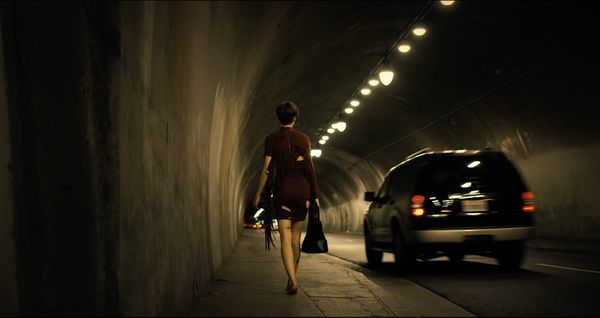 |
| Take Back The Night |
Horror is a common choice for first time feature directors because it doesn’t generally require a big budget and there’s a friendly, receptive audience for it. Gia Elliot’s Take Back The Night, however, is making a much bigger splash than most of its peers, in part because it addresses horrors which are very much part of the real world, it supernatural premise pointing up the absurdity of real life situations which are all too common.
In the film, young artist Jane (Emma Fitzpatrick) is assaulted by a supernatural creature. Even though she is initially careful about how she frames this when talking to doctors and police officers and her sister, she soon finds herself disbelieved, accused of inflicting her wounds herself, even threatened with legal action for making a false report. Her mental health is severely affected. When it emerges that her attacker is stalking her, she realises that she will have to learn to fight back by herself.
The subject is very close to home for Gia, who went to law school and sat on the bench with a criminal judge, observing cases.
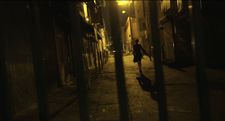 |
| In the alley |
“I saw a lot of sexual violence cases, and it made a big impact on me,” she says. “I really enjoyed my criminal law class. We really dove deep into the way laws are written, and how that language plays out in a courtroom, which I was getting to see first hand. So I was getting to see first hand how the word ‘forcible’ might impact the case. ‘Forcible’ will get lawyers arguing over whether someone's fingernails are ripped up enough to prove that there was considerable force. It’s horrible, just horrible. And I dropped out of law school because it was very depressing, as you might imagine from my description.
“Then I moved to LA and met Emma Fitzpatrick. We were friendly. We discovered a mutual interest in the subject. She had been studying brain trauma and what happens to the brain in the wake of trauma, and she and I started a book club, sort of to discuss these issues. And then our book club became every night and every weekend, a 24/7 club where we just kept talking about it. And so we decided, you know, we really have something to say, something that is grotesque and compelling and demands examination inside of us. Why don't we turn that into a film? Since I came to LA to be a filmmaker, and Emma had been in many films before, so it felt pretty natural.
“I got a camera. I thought, ‘Well, I'll just teach myself how to use it. We don't really need anybody's permission, we can just tell the story.’ And we did not want to make a drama movie, because it felt like, I don't know – I just was so depressed, coming from law school, I didn't want to inflict that same sort of feeling on anybody else. That wasn't the kind of emotion I thought we should be trying to invoke. And I didn't want to make a documentary because I thought anybody who might watch documentaries would potentially already be thinking about these issues. All I wanted to do was just explore this thing inside of me that demanded exploration – and, hopefully, be a conversation starter and be a welcoming door open for people to discuss something that might be a little sensitive.
“I believe people are fundamentally good. I believe that we try very hard not for each other's feelings, and so we might not feel comfortable discussing something like this. So I wanted it to feel welcoming and feel like okay, well, I might say the wrong thing if I'm talking about real people's lives, but if I'm talking about a monster, suddenly I feel like I can walk some ideas out there and see how they play and explore the thing. And so it felt very natural to me to create a metaphor, and because horror is my favourite genre. I was going to make a horror movie.”
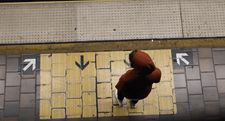 |
| On the edge |
It was clear from the start that Emma would be the star, and it always made sense for her to direct, she says.
“I tried to fight being an artist so hard, and it backfired. But I had been directing my whole life. You know, I have video footage of me as a kid directing little plays with my stuffed animals. And in elementary school, I was desperate to stage Beauty And The Beast, but we didn't have a drama department, so I made a plea to my headmaster of my school that I should be able to do this, and he said ‘Okay, if you can find a adult supervisor,’ so I recruited my mom. And that's how she started her 25 year long career as a drama instructor at this elementary school.
“In high school, I made a short film a week. We had a weird amount of talent at my boarding school too. One of the people who I had cast regularly wound up to be one of the actors on The Walking Dead, and she played a character for six seasons before getting killed off. So, you know, I was used to collaborating pretty directly with real talent and real actors. So I think for me, embarking on directing with Emma as the star felt very natural or organic. We didn't stop to think or investigate. It just was how it was going to happen.”
It makes sense, I say, because the confidence which she has in her approach is striking for somebody at that stage in their career. I ask about the early scene, just before Jane is assaulted, in the alley, and how she framed that to build up a sense of threat.
“I am a huge fan of Dolores Huerta, the American labour rights activist. She says there is power in your body. So even if you are a migrant farm worker, and you do not speak a lick of English, but you know that you deserve proper working conditions, there's power in just showing up. And obviously, I'm also deeply inspired by Wong Kar-wai and his idea that occupying space can be part of the filmmaking and the writing and the discovery process. So we spent a lot of time in that alley. When I look at the footage, I can still smell it in my nose. I would say we shot down there every night for two weeks. I have so much footage in the alley. I crouched down in front of that puddle for 20 minutes, patiently filming the puddle, waiting for the rats to come. I was like, ‘I'm going to get some rats in the alley, I know it!’
“I think the alley scene was hard one. We spent a lot of time trying to earnestly engage with the space and with each other. When I'm holding the camera, and I'm pointing it at Emma, I really like a really wide lens, you know? I'd love to shoot on a 12 but I don’t have a 12. I shot most of it on a 24. So you have to get close, you have to get really close. So that kind of connection was like, it felt like a relationship, it felt like we were telling the story together. It felt like we were dancing. You know, my journals at the time say over and over. I felt like I was dancing. And so we were really telling you a story together. It was a collaborative process, bringing this to life.”
The scene is very much in contrast to the one beforehand, when we're at a party where everything seems very carefully constructed to make us hesitate, watching perfectly innocent actions and knowing the way that they will be used against Jane when she makes her report. She’s not what people think of as a ‘good victim’ – she’s too human.
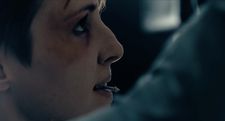 |
| Changing the locks |
“Yeah, I really wanted people to investigate how processing trauma might actually look, to make us all kinder to one another. I think that we often like to imagine someone who's gone through a really painful experience as someone who curled up in bed under a big comfy blanket with a pile of tissues next to them, eating ice cream. I think this is our ultimate victim behaviour, when in reality, it's so much more complicated. I think that there is a general Judeo Christian attitude, especially in the ‘States, of, you know, it's an awful, awful thing if a virginal, pure person is defiled, right? Like, it's not a horrible thing that can happen to anybody. I really wanted Jane to be someone that I would be friends with, that behave like my friends and my peers and had a really rich life. And she's still entitled to be believed.”
We talk about the history of horror films centred on women and children whose stories are not believed but turn out to be true.
“I love in horror movies when women aren't believed because they're considered to be hysterical,” she says.” And then I also love when children see supernatural things because they are just more sensitive, like the kids are always the ones of seeing these ghosts long before the grownups even acknowledge that there might be something otherworldly happening. So while maybe not conscious, I do respect that horror. I think maybe some of that is in there without really even me having planned for it.”
in those older films, however, those characters usually need to get a man to believe them before anything is done about the problem, whereas Jane ultimately learns to stand up for herself.
“We're on a hero's journey, right? This is the victim as protagonist, this is the survivor as hero. To me, one of the most interesting things a person can do is survive. In life, all of us are dealt some rough blows, and we're resilient, and we dig deep, and we find the strength to persevere. And that comes from within, it comes from ourselves. And so Jane similarly taps into that as she goes on her own hero's journey, to own her own story.”
The darkest part of the film, I suggest, comes when Jane begins to doubt her own memory and understanding.
“Yeah. My deepest fear in life is what's real, and says who? Like manipulated reality. You know, you see all these amazing studies about how people who witnessed a crime can be manipulated – even just identifying people in a lineup, like the ways that the police can suggest that it was this person. It retro actively changes people's idea of what happened at the time, and they'll become very convinced that they understand it. It is a very real thing in psychology, that we can manipulate and rewrite each other's memories, and that's really scary. And that's, I think, a huge part of overcoming a trauma or a massive event – you're trying to sort through all your own interpretations of the event. And then on top of that, you have to sort through what everyone else is reflecting back to you about your experience. And that's hard. That's really hard. I really feel for people who are going through that.”
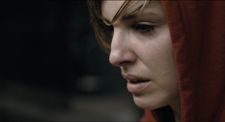 |
| Making her mind up |
Here, obviously, there is also doubt on the part of viewers about what we thought we saw. Particular sound effects which we hear when the the original attack happens keep coming back, and we don't know if it's echoing trauma, or if it's something like that happening again. Was Gia very conscious about that aspect of the sound design from the start?
“Extremely,” she says. “Mapping out when we do and don't believe Jane was one of the most carefully considered parts of the film, down to how much of the monster we see, when do we see them, what will make us doubt her? Even if you don’t see a lot of the monster, you can hear it. How are we going to cut against that? How are we going to make us doubt? In the end to me, the monster is very firmly real. I wanted to make that very clear to people and give them something to hang their hat on. I think there are a lot of things to talk about and a lot of things to discuss, and I didn't really want it ‘Was it real anyway?’ to be one of the questions. So I don't know if I was effective or not, but I was hoping to give people enough meat to sink their teeth into to be confident in the judgement that the monster was real the whole time.”
That confident approach when making the film did not translate into having the least idea what to do to make sure that people saw it.
“I didn't think for a second,” she says. “I just was making it and then making it more. I made this film over the course of five years. We started a late night cinema club. We shot on nights, we shot on weekends. We recruited more people to join our ranks. We got Kwanza Gooden, we convinced her to come on as a producer, which for all practical purposes wound up meaning holding the boom. And then at a fateful Christmas party, Marcus Dunstan, who wrote a bunch of the [fiilm id=15062]Saw[/film] movies, he directed a couple of movies that Emma is in, and he was like, ‘Hey, I heard about your film project. My mom was in the Take Back the Night marches on college campuses in the 1970s. Can I see some of your footage?’ So I showed it to him, and he was like, ‘This is so much better than you guys are treating it as. You could get money. You could finish this with help.’
“I never even stopped to consider that possibly, that I should get money to do this. And he connected us with a film financier. And we got a cheque just big enough to get enough insurance, to look SAG dead in the eyes and say ‘We’re making a movie.’ And so then I just finished it. I didn't really know where it would go, how it would get out into the world. It was not very strategic. I guess I just sort of had to do it. And so I don't know, the film found its own place in the world, I guess.”
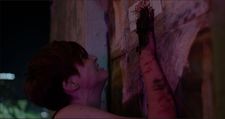 |
| Survival |
So now that it is out there, what are the big important messages that she hopes people will take from it?
“I just want people to feel comfortable talking about it with their friends and exploring ways we might think about treating survivors of any sort of trauma differently. Kinder ways that we might think about. And rewriting laws to also be a little kinder, a little more gentle. Maybe consider some of the human psychology of trauma and not be as blunt. Ways that we might incorporate more brain science into the ways that we try these cases. That's what I'm hoping for.”
She’s not sure that she can ever make a living as a filmmaker, she says – not the way it’s done in Hollywood.
“That is not how I like to work. I made this over the course of five years. I have been working in tech. I love it. And I'm slowly writing my next movie that I will make independently in three years. I like exploring a subject thoroughly, pulling it apart, examining every aspect of it and putting it back together. The commerce and the strategy associated with Hollywood, I found to be a robber of the joy and the reason why I was doing this.
“I am not interested, really, in meeting with people and convincing them to tell the story. The story convinces me to tell it, and then it has a life of its own, so I believe that it will find its people.”
Take Back The Night is available on Arrow from 10 October.





















